The story of the St George Illawarra merger is one of survival, egos, a cultural divide and bungled decisions that led to the rise and fall of the Mighty Red V. Here is the first instalment of our two-part deep dive into the rollercoaster ride that is the modern-day Dragons.
Trent Barrett didn’t know what to say.
The 21-year-old with the baby face and boyish good looks was too nervous to look at the shattered older faces around the room.
Barrett only remembers the anxiety and hurt as the entire room of 30 players stared at a whiteboard on wheels pushed into the corner of the room.


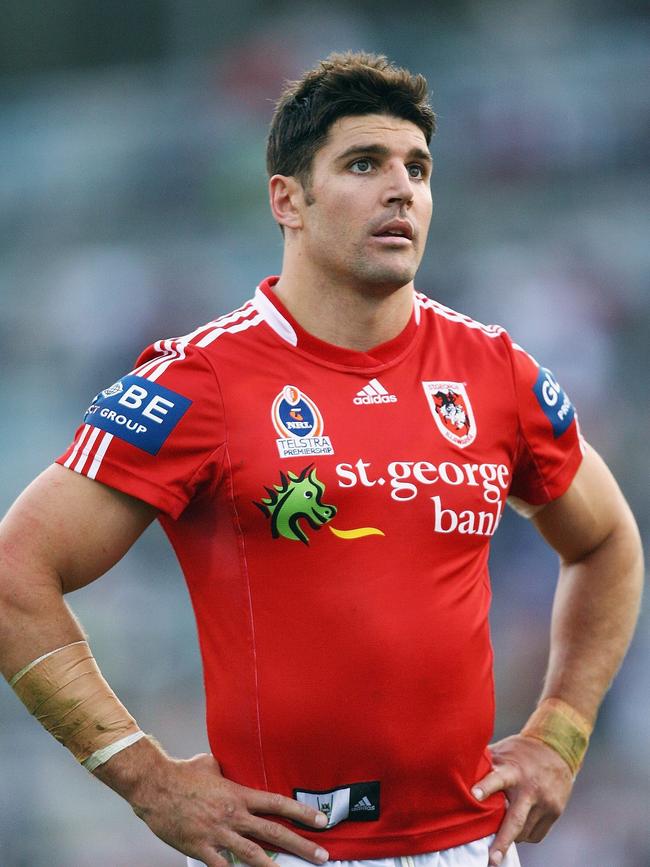
Names written in thick black marker pen were the fallen. Redundant. Finished. The End.
It felt like someone had died. This was the moment that the Illawarra Steelers no longer existed.
“It was brutal. It was highly emotional,’’ Barrett has revealed for the first time.
“A lot of us had come through juniors together and we all lived locally down here (South Coast). And most of the older guys were local blokes too.
“We didn’t know what to say. We had guys like Darren Bradstreet, Dean Callaway and Dave Walsh, Scott Cram – they were diehard Steelers boys.
PART II: THE DEATH OF THE ST GEORGE JUNIOR
“I remember we all just packed up and went to the Harp Hotel.’’
The end of the line for the Illawarra players was also the beginning of an arranged marriage with the St George Dragons that has lasted 22 years.
This was the cold, cutthroat and career-defining meeting of which few, if any within the game, have understood the magnitude.
The meeting, held beneath the grandstand of WIN Stadium after training ahead of what was to be the Steelers’ last ever game as a club – against Canterbury in 1998.
The cull, as painful as any in the game’s history, was required to form the Steelers’ joint-venture with the most famous brand in Australian sport at the time, the St George Dragons.

Here we are, 23 years later, and St George Illawarra – a sporting icon – is the TAB’s rank outsider ($51) to win the NRL premiership, its longest odds going into a pre-season. Dragons coach Anthony Griffin is in a race against time to prove his worth amid a backdrop of apprehension over the club’s recruitment for 2022. You can’t help but go back to those pre-merger days when such was the mood that Red V fans would carry a coffin to matches to symbolise the death of St George. What has gone so horribly wrong?
Told through the eyes of the most influential figures throughout the joint-venture’s journey, this is the story of survival, egos, cultural divide and bungled decisions that led to the rise and fall of the Mighty Red V.
LISTEN! David Riccio, Michael Carayannis and Brent Read go behind the merger of St George and Illawarra and the impact it had on the region.
MERGE OR DIE
The situation was simple – merge or die. Not only for the struggling Illawarra Steelers, who had collected three wooden spoons and only made the finals twice in their 16-year existence, but for the once mighty St George Dragons.
In 1998, rugby league was in the icy grip of paranoia and fear. After the Dragons and the Steelers had opted to remain loyal to the ARL over Super League, they were now fighting for survival a season later.
“Criteria” had become the buzz word within the game and both clubs were increasingly concerned they would be squeezed out of a rebooted 16-team competition in the newly formed National Rugby League.
“St George’s survival would have been line-ball,” then St George chief executive Brian Johnston said.
“It may have survived, but in what form? There would have been a casualty: either the football club or the leagues club.”

THE CASE FOR MERGING
St George had long considered merging with a rival club. Four years before St George Illawarra first took to the field in 1999, St George were in advanced talks with Eastern Suburbs.
Geoff Carr, St George chief executive during the early 1990s, oversaw the Roosters talks.
“Super League had a model of 12 teams,” Carr said.
“There were only going to be four teams in Sydney. Everyone was scrambling for some ground.
“Cronulla tried to do something with St George and Illawarra. (Cronulla boss) Peter Gow’s model was 60 per cent divided between the partners and 40 per cent private ownership.
“A line was put through that. Illawarra had no money and we had no money.
BUSINESS TYCOON LIFTS LID ON DRAGONS’ $11.5m SNUB
“You want to marry a partner with money, so (Roosters powerbroker) Phil Gould and I started talking about it at Origin. It got a fair way down the tracks. Almost got to a heads of agreement.
“The Save Our Saints supporters blew up a treat, which I don’t blame them for. It went all the way down the path, but at the end of the day the board decided against it. The board backflipped.”
At the time, crushed Red V fans carried a coffin onto the hill of Kogarah Oval to mourn the loss of St George.



WILD OPTIONS ON THE TABLE
Other radical plans included St George relocating to Melbourne to take on the Storm’s franchise as part of a push by Super League, or even into Adelaide, given their partnership with long-term major sponsor and winemaker Penfolds.
Warren Lockwood, who became the merged entities’ longest-serving chair, insisted the idea of packing up and relocating to the Victorian capital was given short shrift by the St George hierarchy.
“That was never our intention,” Lockwood said. “We said we’re not leaving our supporter base to go to unknown territory. It never went to a vote. It was a board decision to say we are not going.”
Cronulla seemed the most logical choice for marriage with Saints given the proximity between the two clubs.
“We said we’re not leaving our supporter base to go to unknown territory. It never went to a vote.”
But the Sharks’ ongoing financial hardships and their desire to keep their identity left St George to flick their Shire rivals and instead cast focus further down the coast to Illawarra.
In the back of St George’s mind they believed if they were to bypass the Sutherland Shire, they would eventually swallow up the Sharks. But that never eventuated.
“The business model was closely related to Kogarah and the changing demographics which rolled into football operations,” said Johnston, who would become the inaugural St George Illawarra chief executive.
“If you look at the changing demographics of Kogarah, the number of traditional rugby league families was changing because the demographics changed dramatically:
● Kids were dropping out of rugby league at critical ages.
● The average crowd of Kogarah wasn’t great.
● The membership base was changing. Most were coming from south-western Sydney, which was in line with the changes happening in the St George area.
● Grants from the ARL weren’t great and there was a declining gambling revenue.
“The most important issue was keeping our identity. That was in the name, logo and colours.
“If you looked at the history of Cronulla, they were challenged financially on a number of occasions. We would not have been able to keep our name or colours.
“Illawarra were in a better financial situation but they wanted to get it done because they were hurting financially, too. They couldn’t see how they could grow their crowds without an injection of money.
“We looked at the history with Illawarra and the players who came from that area – including champions Bob Fulton, Steve Roach, Graeme Langlands and Mick Cronin. Rugby league was the dominant sport in the area and it was such a great area for developing players.”
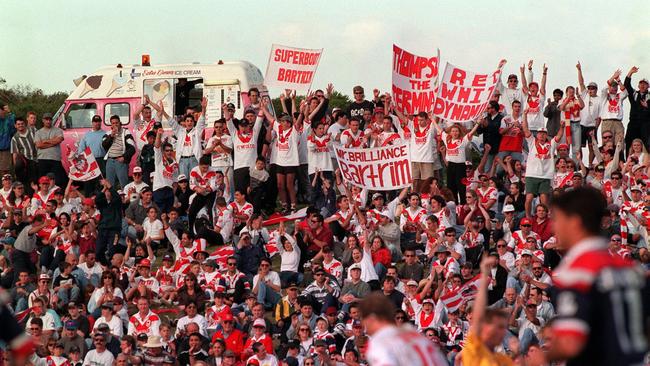
THE SAD DEMISE OF THE STEELERS
Bobby “Steeler” Millward devoted his adult life to fostering rugby league in the Illawarra. When the Steelers were at death’s door more than two decades ago, Millward was one of those charged with coming to its rescue.
Millward was a Steelers man, but he and his fellow directors were faced with two options as rugby league sought to whittle down the size of its competition.
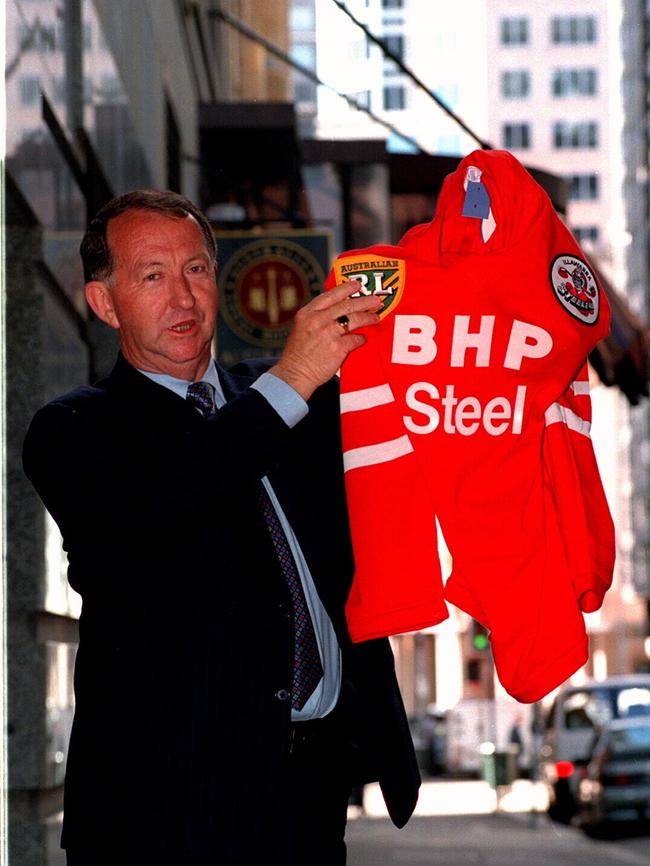
“The criteria that was being set (by the ARL), Illawarra wasn’t going to meet it financially and St George wasn’t going to meet it in relation to juniors,” Millward recalls.
“St George was financially viable and didn’t have the juniors. Illawarra had the juniors but after the withdrawal of (major sponsor) BHP’s support …. it was going to be doubtful that Illawarra could (meet the criteria financially).
“There was talk during the Super League war that Cronulla, St George and Illawarra should get together and have a super club.
“That never grew much at all; it only had brief consideration. St George and Illawarra had a relationship unofficially going back in the 50s and 60s in particular.
“We shared a major sponsor in the early years, Penfolds. They often said ‘we make red wine and we make white wine – one team wears white jumpers and one team wears red jumpers’.”
Ask Millward what would have happened to rugby league in Illawarra without the merger and he paints a gloomy picture.
“It certainly wouldn’t have done it any good,” he says.
“It would have been disastrous (for Illawarra) and I think it would have been disastrous for rugby league. The theme we picked up in our centenary year of 2011 – the book was titled Nursery of Champions, and we still are.
“We are still producing good footballers. They don’t all remain with the Dragons – some go to other clubs. That happens with every club.
“The area that we are, we were attracted to the joint venture as a production line. I think we still are.”
The St George Illawarra Dragons were born on September 23, 1998, with a 50 per cent ownership share between the Steelers and the St George. A plan to call the side the St George Steel Dragons was ditched. The NRL handed the game’s first merger an $11 million grant and an inflated salary cap in its first year.
CITY V COUNTRY: THE ULTIMATE CULTURE CLASH
Initially for the players, Barrett said it felt like the merging of the Dragons and Steelers was like trying to fit a square peg into a round hole.
“It was a difficult time bringing two totally different cultures together. And we had to say goodbye to half of our mates, too,’’ Barrett said.
Asked about the teething problems, Barrett said: “For starters, we had the two head coaches from either team in Waitey (David Waite) and Andrew (Farrar).
“We (Steelers players) always had a pretty close affiliation with Andrew. And the Dragons boys had a close association with Waitey. We were from totally different cultures.
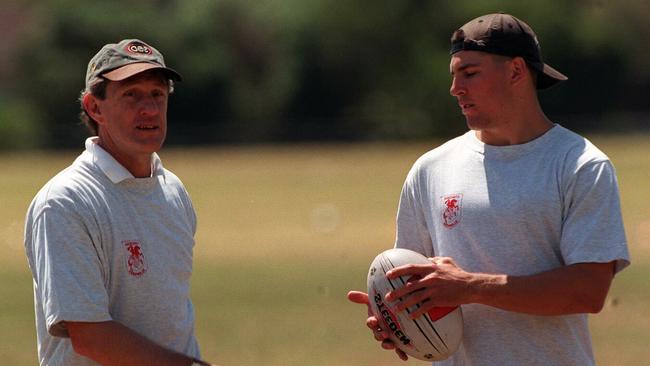
“I remember the first beer we had together. Most of us were country boys, so we turned up in thongs and flannelette shirts ... pretty ordinary clobber.
“And the Dragons boys, like Brownie (Nathan Brown), Choc (Anthony Mundine) and Pearso (Corey Pearson), were well dressed to go to Northies (in Cronulla) and we were used to going to the Harp Hotel (in Wollongong).
“I remember thinking, ‘Oh shit, this will be different.’ They were good blokes, but it took a while.’’
Barrett, with the benefit of first-hand experience and hindsight, has his own view of the joint-venture.
“Bobby Millward is a good friend of mine and I owe him a lot, but he was a staunch ARL man,’’ Barrett said.
“And you look back in hindsight and you think, ‘Had we gone with Super League, would they (Steelers) still be here?’.
“I thought Wollongong was big enough to sustain a team, particularly with the junior base we had, and that they still have.
“Bobby probably thought they were doing the right thing and being loyal to the ARL, but had they gone with Super League, things may have been a bit different. I don’t know.”
HOW TO BRING TWO WARRING PARTIES TOGETHER
The 25-man squad was divided as evenly as possible with 13 St George players included.
“I was charged with how we would approach amalgamating the football side of the club,” said Waite, inaugural co-coach of the new entity.
“I was specifically involved in putting the two football clubs together from a player point of view and medical, sport science and logistics.
“How could the football operate between different training venues, and which players would be kept and let go?
“How would you then mesh a group of blokes who some were more country than city and the others more city than country?
“Even prior to deciding which players we kept, we wanted to make it as even as possible.
“The merger gave us a massive growth in junior pathways and a successful pathway system which now came under the St George Illawarra umbrella.
“We had a picture for long-term success – if you were growing your own.
“I wanted to have duplicate SG Ball and Harold Matthews teams. In Newcastle we had 75 per cent of our players from the region. We were aware from a football sense that is what is needed to happen. Andrew and I went very close to coaching 50/50.”
Even the first player meeting between the newly formed club and the coaching staff got off to a rocky start.
The 25 players were told to meet halfway between Wollongong and Kogarah at a golf course in Campbelltown.
“Craig Smith was the only one we hadn’t signed (for the merger team),” Waite said. “I said, ‘We’re not leaving until everyone is on board’. He was the last piece in the jigsaw puzzle.
“We made a couple of promises to Craig. We could then walk away and say, ‘This is us, this is the playing roster and it should be good enough to play in the final game of the year’.”
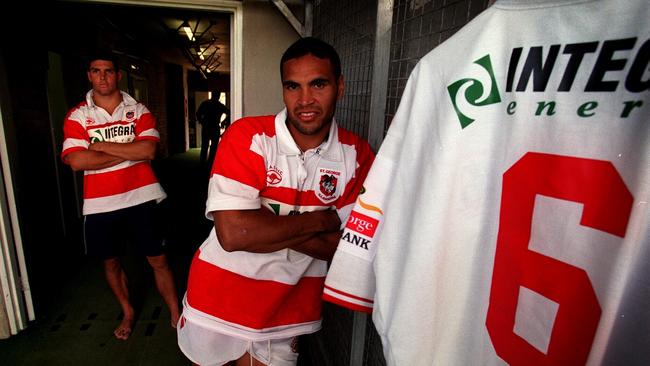
The first big obstacle was who would wear the No.6 jersey.
Anthony Mundine and Trent Barrett both wanted the spot, but in the end Mundine would walk out for the first clash against Parramatta with the six on his back.
“They were two talented players and we got the best out of both of them,” Waite said.
“It was prickly for a while, but last time I saw them together they were great mates. It wasn’t dramatic because they were good people.
“The key was the leadership from the senior players in Mark Coyne and Craig Smith. They were very important.”
The Dragons lost their opening two matches of the 1999 season, but won 11 of their last 13 games to qualify for the finals and then progressed to the grand final.
They had beaten Melbourne 34-10 in the opening week of the finals, but they blew a 14-0 half-time lead to lose to the Storm in the decider.
Jamie Ainscough etched his name in grand final folklore with his tackle on Storm opposite Craig Smith, which resulted in a penalty try in the dying stages of the match.
THE UNRAVELLING OF A PREMIERSHIP FORCE
Waite sensed things were unravelling in 1999 when confidant Nathan Brown told him the players weren’t responding to the two coaching voices.
Aware of this, Waite, who maintained a strong relationship with Farrar, approached the board seeking some clarity on the club’s long-term coach.
The 70-10 loss in a round 5 grand final rematch to Melbourne in 2000 was Waite’s undoing.
Mundine, who declared the Storm were not “worthy premiers” in the lead-up to the game, played five more games before fleeing to the US. Waite would soon follow him out the door.
“Year two became a bit awkward after the huge defeat (to Melbourne),” Waite said.
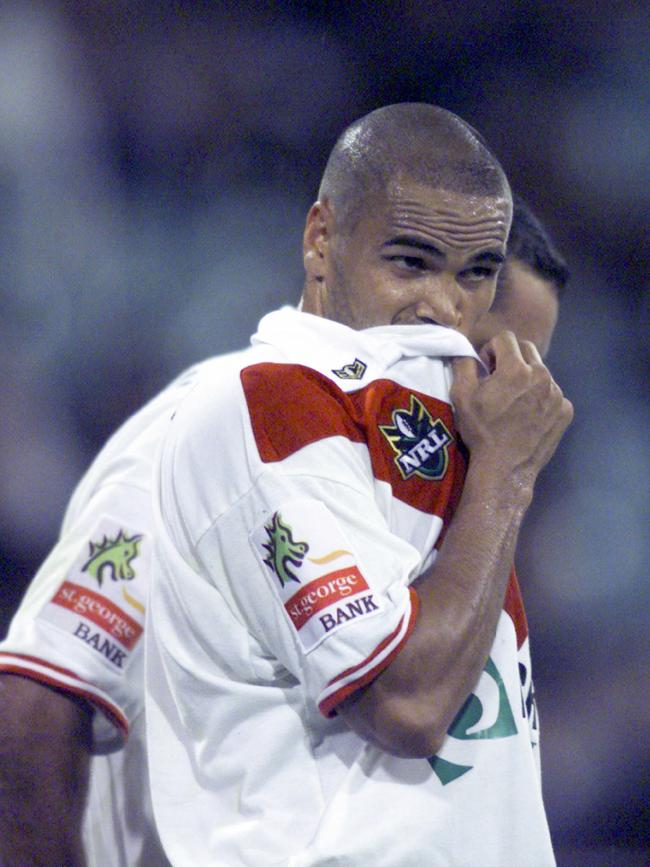


“The interesting thing about that defeat was the same team beat Melbourne by 50 a few weeks later (in round 18).
“The signs were obvious and the rumblings were there.
“It was an interesting dynamic in the group. Everyone reacts to those things differently. Any fractural weakness would appear after a massive loss. The us and them, Illawarra and St George dynamic (surfaced).
“From that game (round 5), those that believed Anthony was a negative impact may have had more power or sway at the board level.
“When push came to shove, (the Steelers) got the extra vote. I may have been aware of the swing and I may have had to convince people from the St George side that the swing had taken place.
“Andrew and I had been trying to get them to make a decision as soon as possible because that was disrupting the team.
“It wasn’t until my birthday that year that I got the phone call. I knew what was going to happen and I was comfortable. I knew what the outcome was going to be.’’
SAINT WAYNE: THE JOINT-VENTURE’S CROWNING MOMENT
Andrew Farrar took the Dragons to the finals two years in a row before prodigal son Nathan Brown was tasked with delivering a premiership.
Brown was only 29 when he took over as head coach in 2003.
He was much-loved as a player, with his career ended by a neck injury in a trial game in 2001.
Brown’s first foray into NRL coaching finished with a more than respectable four finals appearances from six seasons at the helm.
But it wasn’t enough to save his job. The axe fell on April 1, 2008, with the joint-venture convincing Wayne Bennett to sign on for the next season.
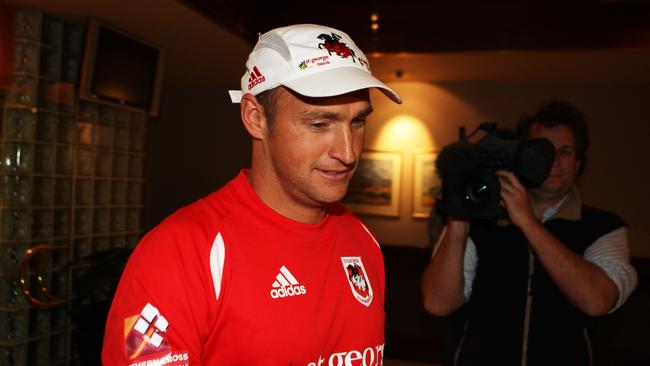


Brown pushed aside ego and stayed until the end of the 2008 season, departing the club after a 38-6 week-one finals loss to Manly at Brookvale Oval.
He finished at the Dragons with a 53 per cent winning strike rate, third overall behind David Waite (56.3 per cent) and Bennett (64.6 per cent).
Bennett’s appointment was – and still is – the joint venture’s crowning glory. He was signed as Dragons started the 2008 season with one win and two losses under Brown.
Bennett, who had spent 20 years with the Broncos and collected six premierships, didn’t waste time getting to work ahead of his arrival in 2009.
Talking to News Corp about how he led the joint-venture to their first and only title in 22 years, Bennett said he began by making key decisions as soon as he arrived – on and off the field.
“I love Peter Doust (former Dragons CEO), but I said to him when I arrived, you stay at Kogarah, I’m going to Wollongong,’’ Bennett said.
“I said to him, ‘If I need you, I will ring you’. Otherwise, stay away and we’ll get the job done.
“Well, he had the best three years as CEO he’s ever had because he didn’t have to come down (to Wollongong) or have a thing to worry about.’’
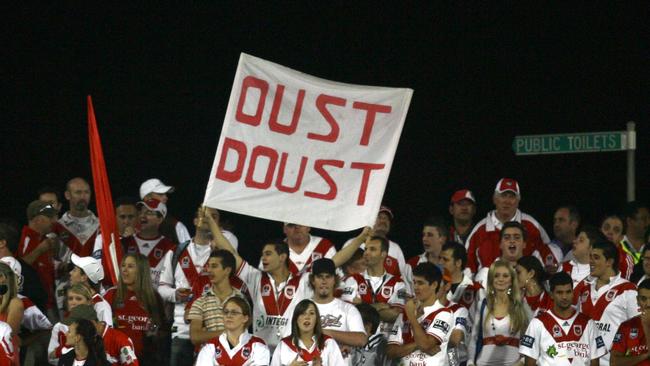
Bennett added: “I arrived in 2009 at an opportune time. They already had some talent, but we had to patch up other parts of the team.
“I brought Michael Weyman with me. I’d watched him at Canberra and thought this guy is better than what he’s showing.
“Darius Boyd came, he was still young and we put him at fullback.
“They’d lost Josh Morris, which they blamed me for, but that wasn’t my doing.
“I cleaned the coaching staff out and we went on and won the minor premiership.’’
“We had a great season. But our failing was we played Parramatta in the last game of the regular season and trounced them. And then we had to play them the following week, when it was 1 v 8 in the finals.
“They bounced back, which I knew they would, and they beat us.
“So we then found ourselves in Brisbane against the Broncos – and we all know that they’re going to lift against their old coach.
“Peter Doust got Mark Gasnier back (in July 2010 from French rugby union), which was a big play for us.
“We won the minor premiership again and this time we nailed it by winning the premiership.
“To win minor premierships is bloody hard. To win two in a row was special.
“But the thing was we had a great squad of players there, and so the squad got us through. We had 30 players all on the same page.”
THE BEGINNING OF THE END
Bennett points to premiership-winning five-eighth Jamie Soward as a central figure in the rise and rapid demise of the Dragons.
“Everyone had an opinion on Jamie Soward. He was in the top five most-maligned players that I ever coached,” Bennett said.
“So I made a deliberate decision to form my own opinion and not listen to everyone else’s for the first six months that I coached at Saints.
“I watched him and I realised he was a free spirit. He didn’t like a game plan, but he could do things that other players couldn’t do.

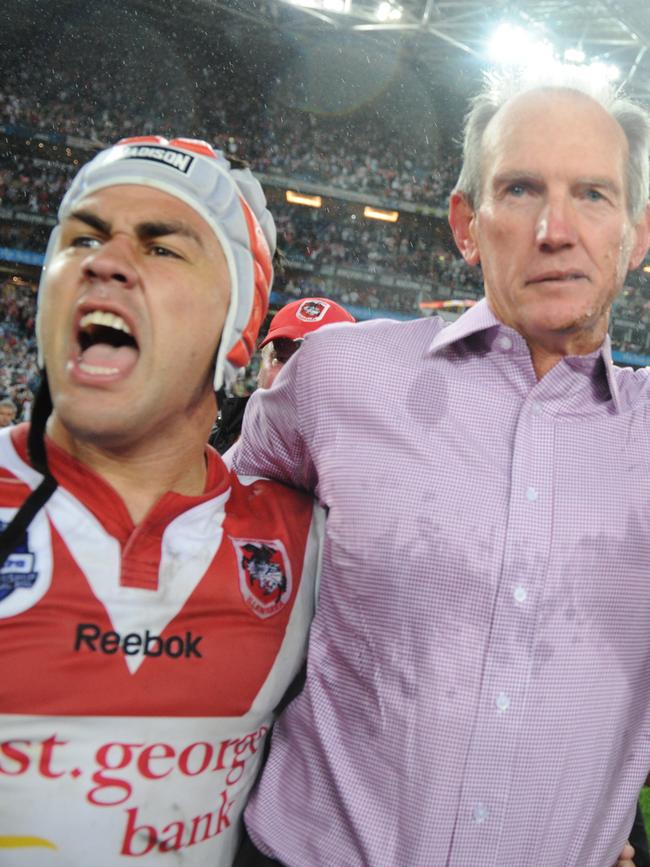

“So I loaded (hooker) Dean Young and (captain) Ben Hornby up with a game plan and we let Sowie be Sowie.
“He went on to win a premiership, world club championship, two minor premierships and played for NSW.
“We got through three years with it and six months into me leaving, Jamie is gone, too.
“That was the first poor choice they (management) made. When he left, they didn’t have a five-eighth.
“For me that was the catalyst for what happened going forward. From then on, their recruitment has been questionable at best.
“They had to rebuild the club, I understood that.
“But I just couldn’t understand some of the decisions they made and how they went away from what they knew worked.’’
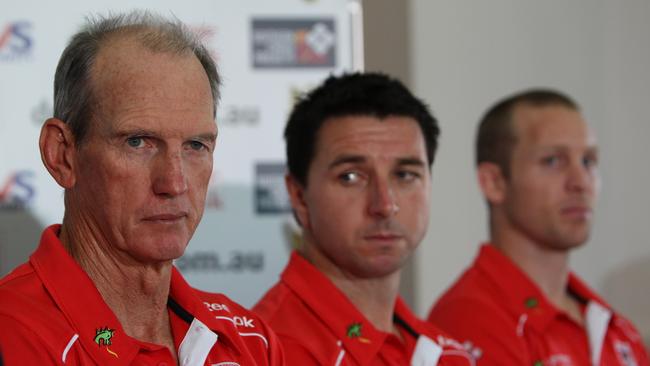
Bennett explained his decision to finish up at the club in September 2011, following a heartbreaking 13-12 semi final loss to his former club the Broncos.
“I left because one of the things that worried me was that they had a lot of players coming towards the end of their careers,’’ Bennett said.
“Dean Young, Ben Hornby, Mark Gasnier and Matt Cooper were among them and after achieving so much with them, I didn’t see myself staying long-term.
“I said, ‘Wayne, it’s time to get out. I looked at their (management) record of sacking coaches before me, so I thought I’d get out.
“But overwhelmingly, these players had given so much, played so well for me, that I just couldn’t stay for the rebuild.
“Steve Price took over and he’s a good coach. There’s no doubt in my mind.
“But soon enough he was on the way out and then they brought Paul McGregor in.’’
Bennett also made it clear that at no stage – adding he wouldn’t have allowed it – was there an issue of any divide or factions among the St George or Illawarra boards or players.
“I think they’re a great club. It’s a great brand. And I loved being their coach. Their fans are phenomenal,’’ Bennett said.
“Wherever I go in Australia now, the guy that walks up to me is always a Dragons fan. They’re everywhere.’’
Asked when he felt the joint-venture could win a premiership again, Bennett said: “That, I don’t know.’’


Add your comment to this story
To join the conversation, please log in. Don't have an account? Register
Join the conversation, you are commenting as Logout
Gallen and SBW tensions fly in spicy scenes
Paul Gallen and Sonny Bill Williams had words for each other in a heated exchange in the ring following their controversial fight.
Joey Johns makes stunning Ponga statement
Andrew Johns has weighed in on Kalyn Ponga’s uncertain future as the Newcastle Knights lurch from one disaster to another.